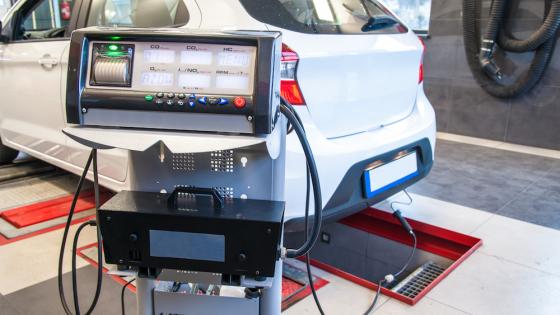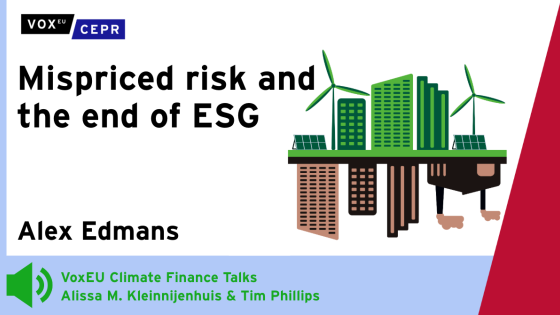In 2009, the EU adopted an emission standard for the automobile market that required automakers to decrease emissions, averaged over their yearly sales, to 130 grams of CO2 per kilometer by 2015. Emission standards are an often-used tool by governments to reduce emissions in the transport sector. The US implemented the Corporate Average Fuel Economy Standard (CAFE) in 1975, and today all major vehicle markets – from China to Mexico – have an emission standard. The new EU standard was one of the most demanding environmental policies in the global automobile market, requiring automakers to reduce emissions by 18%.
Economists have extensively studied the CAFE standard. Goldberg (1998) develops a model to study automakers' pricing in response to an emission standard. Jacobsen (2013) extends the framework to account for distributional effects among consumers and firms. Evaluating the welfare impact of emission standards is not an easy task. In Reynaert (2020), I discuss how firms can choose between different strategies to reduce emissions and how, in turn, these different abatement strategies result in different welfare outcomes.
- A first strategy that firms can employ to lower emissions is to change pricing to shift the sales mix to vehicles with CO2 emissions below the target.
- The second strategy is downsizing: firms can sell smaller and less powerful vehicles that are more fuel efficient.
- The third strategy is technology adoption: firms can improve the fuel efficiency of their vehicle fleet by adopting technologies that improve the combustion process.
- A fourth strategy is ‘gaming’. To establish emission ratings, the regulator requires that vehicles go through a test procedure. Firms may reduce emissions during the test procedure but not necessarily on the road. Enforcement of the emission standard plays a role in limiting gaming.
Looking at a detailed panel of vehicle attributes, prices, and sales for the EU market, I find no evidence of price changes or downsizing in response to the emission standard. Instead, there is a pattern that Knittel (2011) also observed in the US market: every year, automakers make vehicles that are more powerful, accelerate faster, and are larger, while emissions do not increase. In other words, there is technological progress in this market. If automakers use this technological progress to make more fuel-efficient vehicles, the firms should be able to comply with emission standards. Technological progress is what happened in the EU market: improvements in vehicle technology have happened twice as fast after the announcement of the EU emission standard. However, this is the result of looking at official emission numbers obtained from laboratory tests.
In a forthcoming paper, my co-author and I compare the laboratory ratings, which form the basis of policy, with direct measures of on-road fuel consumption (Reynaert and Sallee forthcoming). We construct a data set that tracks fuel consumption and kilometres travelled for a panel of more than 250,000 drivers for 12 years in the Netherlands. Using these data, we estimate the percentage difference between the laboratory test and on-road performance (which we call the performance gap) for each vehicle vintage and model. Figure 1 documents a sharp rise in the performance gap coincident with policy change. Vehicles produced before 2007 show a small, relatively stable performance gap. Vehicles produced after that exhibit a large and rising performance gap, so that the 2014 model‐year vehicles have performance gaps above 50% on average. The rise in the performance gap implies that around 65% of the gains in fuel economy since the introduction of the policy, as measured by laboratory tests, are false.
Figure 1 Official and on-road fuel consumption ratings and performance gap
Source: Reynaert and Sallee (forthcoming)
The empirical evidence presented thus far shows that automakers chose to respond to the EU emission standard by increasing technology adoption and by gaming the tests. The response raises two questions. First, what are the welfare effects of emission standards when compliance strategies are technology adoption and gaming rather than price changes? Second, why did we observe this market response to the EU standard? To answer both of these questions, I develop and estimate a structural model of vehicle demand and supply to study the impact of the regulation on consumers, firms, and the environment (Reynaert 2020).
Because of technology adoption, firms' costs increase. The increase in costs reduces profits and lowers consumer surplus. Because of the gaming, the reductions in actual CO2 emissions are a mere 5% instead of the 18% target. The sum of the value of emission savings and consumer and profit losses is negative so that the regulation reduces welfare. However, when I consider two additional non-targeted welfare effects, I find the emission standard to have a small positive impact. The emission standard also reduces other externalities, such as local pollution, congestion, and accident risk. This includes a correction for consumer undervaluation of fuel economy, as in Grigolon et al. (2015). The economic model also allows studying how the market outcomes differ if the EU designed the regulation differently. I focus on two aspects: the attribute base of the standard and the lack of enforcement.
First, I study the attribute basing, which makes the emission target dependent on vehicle weight. Firms selling more lightweight vehicles face a more stringent attribute-based target. I find that attribute basing makes it much costlier to lower emission by changing prices. Firms have to distort prices more to reach the target because there are fewer vehicles to which firms can shift sales. If the regulation has a flat target without attribute basing, firms opt for changing prices together with some technology adoption. The flat target reaches actual CO2 emission reductions of 11%, much closer to the 18% target. Why, then, was the attribute basing introduced? The attribute basing redistributes the incidence of the regulation between French, Italian, and German producers. The simulations show that the positions of the national governments are in line with the interests of their domestic firms. The French and Italian governments were in favour of regulation without attribute basing, while Germany lobbied for a steep attribute design.
Gaming is also a product of the political environment. A recent evaluation by the European Parliament has placed responsibility for enforcement failures with the car producing member states. The economic model in this paper allows computing the effects of better enforcement. A better test procedure would mean that official and actual emissions are more similar. With more enforcement, the reductions in consumer surplus and profits are higher. Firms have to adopt costlier technology, and this increases prices further. But enforcement would have led to much higher CO2 and other externality savings, and the policy would have been welfare improving. Overall, this shows that understanding both the political and practical implementation of emission standards in combination with strategic responses is crucial to understand the welfare consequences of emission standards.
References
Goldberg, P K (1998), “The Effects of the Corporate Average Fuel Efficiency Standards in the US", Journal of Industrial Economics 46(1):1-33.
Grigolon, L, M Reynaert and F Verboven (2015), “Fuel Taxes versus Car Taxes to Reduce Fuel Consumption”, VoxEU.org, 10 January.
Jacobsen, M R (2013), “Evaluating US Fuel Economy Standards in a Model with Producer and Household Heterogeneity", American Economic Journal: Economic Policy 5(2):148-87.
Knittel, C R (2011), “Automobiles on Steroids: Product Attribute Trade-Offs and Technological Progress in the Automobile Sector", American Economic Review 101(7): 3368-99.
Reynaert, M (2020), “Abatement Strategies and the Cost of Environmental Regulation: Emission Standards on the European Car”, The Review of Economic Studies, forthcoming.
Reynaert, M and J M Sallee (forthcoming), “Who Benefits When Firms Game Corrective Policies?”, American Economic Journal: Economic Policy.





